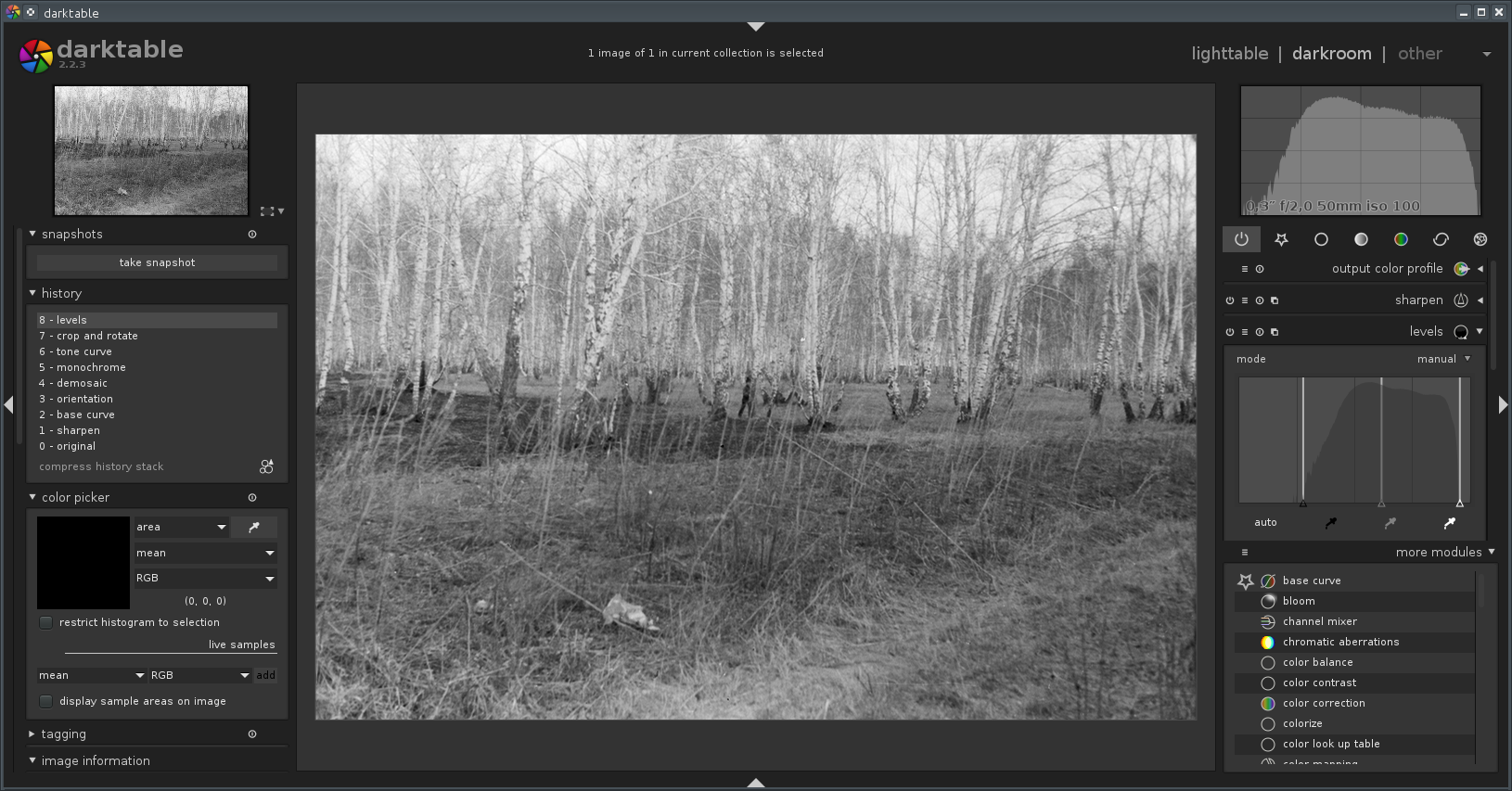Сказ о том, как я проекты darktable с версии 2.0.X на 2.2.3 переводил
Опубликовано 2017.02.27
После перехода с Kubuntu 14.04 на 16.04 появилась возможность обновить darktable с версии 2.0.X до 2.2.3, но внезапно выяснилось, что старые проекты, в которых использовалась коррекция уровней (levels), отныне открываются некорректно.
При попытке открытия проекта в глаза бросаются неверно выставленные уровни.
Ползунки уровней белого/черного/серого отображаются “зеркально”:
На официальном IRC канале #darktable сказали следующее:
<LebedevRI> that is a really bad thing, and unfortunately, there isn't any real way to fix this. it was not intentional change
<LebedevRI> the problem is, levels module happened to swap places with tonecurve module. twice. before 2.0 it was like you see with 2.2
<LebedevRI> so to fix this locally, you can just swap these two numbers https://github.com/darktable-org/darktable/blob/master/src/iop/tonecurve.c#L626 https://github.com/darktable-org/darktable/blob/master/src/iop/levels.c#L511
Жаль, но что поделаешь? Бывает.
Пересобирать darktable ради открытия старых проектов ни малейшего желания у меня не возникло, поэтому я выбрал другой путь: изменить значения уровней прямо в файлах проекта.
Секция с конфигурацией плагина levels в файле *.xmp выглядит следующим образом:
<rdf:li
darktable:operation="levels"
darktable:enabled="1"
darktable:modversion="2"
darktable:params="0000000000000000000048420000c842d9ce373da19bc43eb41e393f"
darktable:multi_name=""
darktable:multi_priority="0"
darktable:blendop_version="7"
darktable:blendop_params="gz12eJxjYGBgkGAAgRNODESDBnsIHll8ANNSGQM="/>
</rdf:Seq>
где в darktable:params хранится структура с настройками плагина в шестнадцатиричном представлении:
typedef enum dt_iop_levels_mode_t
{
LEVELS_MODE_MANUAL,
LEVELS_MODE_AUTOMATIC
} dt_iop_levels_mode_t;
typedef struct dt_iop_levels_params_t
{
dt_iop_levels_mode_t mode;
float percentiles[3];
float levels[3];
} dt_iop_levels_params_t;
фактически, чтобы вернуть уровни на место достаточно изменить значения
float levels[3] следующим образом:
levels[0] = 1.0 - levels[2]
levels[1] = 1.0 - levels[1]
levels[2] = 1.0 - levels[0]
после чего уровни должны занять свое прежнее положение.
Чтобы автоматизировать процесс преобразования *.xmp файлов пришлось
закостылять скрипт на python:
#!/usr/bin/python3
import struct
import binascii
import sys
if len(sys.argv) != 2:
print("Usage:")
print(" darktable_xmp_migrate_from_2_0_X_to_2_2_3.py filename")
print("")
print("Please note the file will be rewritten. Be sure you created a backup")
sys.exit(1)
out = []
stage = 0
stage_lines = [
"<rdf:li",
"darktable:operation=\"levels\"",
"darktable:enabled",
"darktable:modversion",
"darktable:params"
]
fin = open(sys.argv[1])
while True:
line = fin.readline()
if line == "":
break
linestrip = line.strip()
lineseg = linestrip.split("=")
if stage == 0 and linestrip == stage_lines[0]:
stage = 1
out.append(line)
continue
if stage == 1 and linestrip == stage_lines[1]:
stage = 2
out.append(line)
continue
if stage == 2 and lineseg[0] == stage_lines[2]:
stage = 3
out.append(line)
continue
if stage == 3 and lineseg[0] == stage_lines[3]:
stage = 4
out.append(line)
continue
if stage == 4 and lineseg[0] == stage_lines[4]:
stage = 0
paramhex_pre = lineseg[1][1:33]
paramhex = lineseg[1][-25:-1]
infloathex1 = paramhex[0:8]
infloathex2 = paramhex[8:16]
infloathex3 = paramhex[16:24]
infloat1 = struct.unpack('<f', bytes.fromhex(infloathex1))[0]
infloat2 = struct.unpack('<f', bytes.fromhex(infloathex2))[0]
infloat3 = struct.unpack('<f', bytes.fromhex(infloathex3))[0]
outfloat1 = 1.0 - infloat3
outfloat2 = 1.0 - infloat2
outfloat3 = 1.0 - infloat1
outfloathex1 = hex(struct.unpack('>I', struct.pack('<f', outfloat1))[0])[2:].rjust(8, '0')
outfloathex2 = hex(struct.unpack('>I', struct.pack('<f', outfloat2))[0])[2:].rjust(8, '0')
outfloathex3 = hex(struct.unpack('>I', struct.pack('<f', outfloat3))[0])[2:].rjust(8, '0')
out.append(" %s=\"%s%s%s%s\"\n" % (lineseg[0], paramhex_pre, outfloathex1, outfloathex2, outfloathex3,))
continue
stage = 0
out.append(line)
fin.close()
fout = open(sys.argv[1], "w")
for line in out:
fout.write(line)
fout.close()
От же на github gist: https://gist.github.com/AlekseyDurachenko/5f831d6051dad70a0356685a0e815f17
Скрипт перезаписывает существующие файлы. Перед использованием убедитесь, что сделали резервную копию данных.
Результат

Файл получился в точности таким же, каким и был.
Так что если вы тоже столкнулись с этой проблемой, то можете воспользоваться данным рецептом.
Удачи!
Ссылки
- darktable - бесплатная и свободная компьютерная программа с открытым исходным кодом, предназначенная для обработки и каталогизации цифровых изображений.



